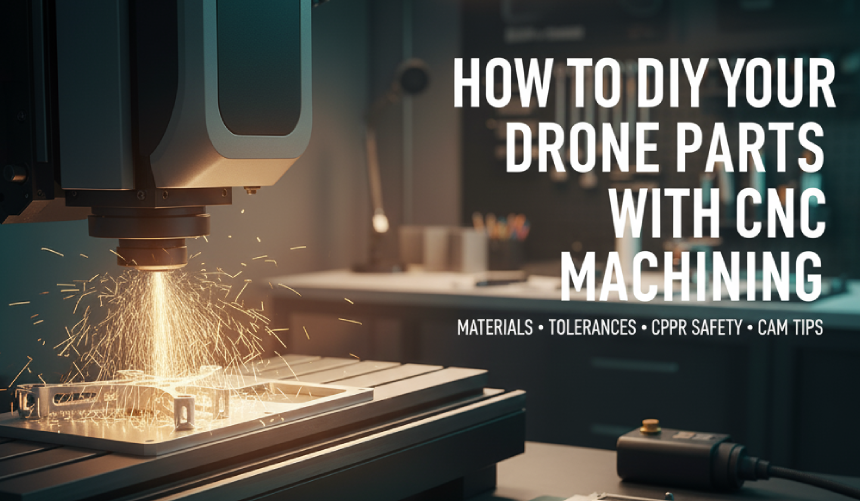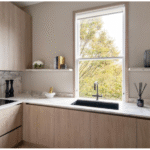You can build clean, strong, flight‑ready parts at home. With the right plan, tools, and a few shop habits, you’ll turn raw plate and bar into arms, mounts, and plates that bolt up perfectly. Along the way, we’ll call out traps to avoid and the checkpoints that keep your build reliable. We’ll use CNC Machining once early and keep the rest simple and practical.
Most hobby frames are flat plates and small brackets—perfect starter parts. You’ll learn how to pick light, tough materials; set tolerances that actually matter; and cut composites without filling your space with dust. We’ll go from CAD to G‑code, cover finishing, and wrap with post‑flight checks so you can iterate fast. By the end, you’ll have a repeatable process you trust—and parts you’ll be proud to fly.
Pick Materials
Start with light, stiff options and save heavy metals for small, high‑load parts. Use 6061 aluminum for general brackets, 7075 aluminum for arms or mounts, CFRP for plates, and titanium only where strength per gram matters. Finish where it adds value, like anodizing for corrosion resistance.
Aluminum, CFRP, Titanium
6061 aluminum cuts easily, holds threads well, and is forgiving—ideal for the first motor mount or electronics tray. 7075 aluminum is stronger and stiffer for the same thickness, so you can trim weight on arms or brackets without flex. CFRP plates offer the best stiffness‑to‑weight for a flat drone frame but need sealed edges and careful dust control. Titanium shines in tiny, high‑stress fasteners or skids; it’s pricey and slower to cut, so reserve it for parts that truly see hits or heat.
Plastics and hybrids
Meanwhile, engineering plastics like nylon, acetal, and polycarbonate work well for camera shrouds, wire guides, and spacers. They cut fast, damp vibration, and won’t dent nearby parts in a crash. Nylon absorbs some moisture; acetal machines crisply and stays dimensionally stable. Consider composite sandwiches—thin CFRP over a soft core—for payload decks where stiffness matters more than impact resistance. Keep plastic fasteners out of hot zones near ESCs or motors.
Surface treatments
Additionally, finishes extend life in the field. Clear or hard anodizing protects aluminum arms and plates from corrosion and wear. Tumbled edges remove burrs that can nick battery straps or wiring. For titanium, light bead‑blast reduces glare and improves grip. Seal CFRP edges with thin CA or epoxy to prevent delamination and reduce dust in later service.
CNC Tolerances and Fits for Drones
Tighten only where it matters. Use shop‑standard ±0.005 in to start, then tighten bores, bearing seats, and stack‑ups that affect flight stability.
Critical Tolerances in Drone Parts
In practice, motor pilot holes, bearing seats, and camera‑gimbal pivots must be snug and concentric to avoid vibration. Battery tray hole patterns need repeatable spacing so parts can be swapped quickly after a crash. Keep arm‑to‑hub interfaces flat and square; a tilted arm causes thrust misalignment and drift. For prop guards or ducts, hold thickness and roundness so airflow stays smooth, or your tune will chase noise you built in.
Holes and Slots for Easy Assembly
Consequently, stick to standard drill sizes and tap callouts to match off‑the‑shelf hardware. Add small clearance slots for ESC or RX mounting so parts fit without forcing. Counterbore socket heads where the stack needs flush faces. If two plates stack, define a reference datum and match‑drill after the first cut so holes share a pattern. Add generous lead‑ins on tabs; they feed easier and survive more swaps.
What CNC Machining Setup Do You Need?
A desktop router handles plates; a benchtop mill shapes blocks; 5‑axis machining helps only when geometry demands it. Pick tooling and dust control before the first cut.
Router vs. mill vs. 5‑axis
Specifically, routers excel at flat CFRP and aluminum plates using small end mills. They’re fast to set up and perfect for frames, gimbal plates, and battery trays. Benchtop mills add rigidity for pockets, tapped holes, and square brackets from bar stock. Save 5‑axis machining for complex housings or when you need undercuts and single‑setup accuracy; otherwise, it adds cost and complexity you don’t need for a beginner airframe.
Workholding and Tool Choices
Moreover, hold plates with tape and super-glue, vacuum tables, or low‑profile clamps that stay away from the toolpath. Use single‑flute carbide for aluminum chips; keep chips clear with mist or air. For CFRP, choose a burr or compression bit to fight fray; avoid flood coolant and plan for full enclosure or wet‑cut trays to capture dust. On mills, use soft jaws or simple angle plates to keep brackets square while tapping holes.
Lightweighting Tactics for Strength
Pocket where loads are low and rib where they’re high. Keep fillets inside corners and avoid deep, narrow cavities that chatter.
Pockets and Wall Thickness
For example, thin walls ring and flex. Keep metal walls near 1.5–2.0 mm for small brackets and go thicker around fasteners. Add radii to internal corners to match tool diameters; sharp corners slow cutting and crack sooner. Pocket with smooth, sweeping curves; abrupt steps invite stress risers. In plates, use large holes and lightening features away from bolt lines so clamps still have material to bite.
Topology and Lattices for Frames
Generative ideas shine in arms and crossbeams. Remove material where your FEA or gut says stress is low; keep continuous load paths straight from motor to hub. Lattice inserts in thick areas can save grams, but verify stiffness with a simple flex test. If you lack analysis tools, prototype two versions and flight‑test for vibration and crash survival before committing to batch cuts.
Cutting Carbon Fiber Safely
Composites cut nicely with the right bit and containment. Treat dust seriously; protect lungs and keep it off the machine.
Tooling and edge finishing
Furthermore, a burr‑style end mill or compression bit reduces pull‑up and fray. Run high RPM with light step‑downs and support the sheet on a sacrificial backer. Chamfer edges with a dedicated bit or hand‑dress with 220‑400 grit; then seal edges with thin CA. Avoid drilling stacks dry; peck carefully and back the hole to keep fibers from exploding out the bottom.
Dust Control and Safety Tips
Use a full enclosure and HEPA extraction, or submerge cuts in a shallow pan for wet routing. Wear a half‑mask respirator with P100 filters, sleeves, and gloves; vacuum the enclosure before opening. Bag chips and wipes, and wipe rails afterward. If the machine isn’t sealed, dedicate it to composites or expect wear from abrasive dust.
Machine Common Parts
Flat parts are quick wins; small brackets come next. Standardize fasteners, hole circles, and standoff lengths to simplify spares.
Motor mounts
A round motor mount with a pilot boss centers the bell and keeps thrust true. Add slots for wire relief and use slightly thicker landing gear tabs where landings hit hardest. A stiff gimbal plate isolates camera mass from the main frame; slot it for balance and add rubber bobbin patterns you can change later.
Battery trays
Battery trays need long slots for straps and smooth edges to save packs. ESC plates with wide airflow slots stay cool; round sharp corners to protect insulation. Cut standoffs from tube or rod and face both ends for square stacks; keep one standard height across the build so plates interchange after a bump.
CAD/CAM Flow
Model with manufacturable features, then create toolpaths that avoid deep skinny pockets and needless tool swaps. Keep your CAD/CAM files organized.
DFM choices
Using standard hole sizes, consistent counterbores, and common thicknesses reduces CAM time and scrap. Add radii that match common cutters so finishing passes sing instead of chatter. Avoid deep pockets unless weight drops are massive; move holes away from edges to protect threads. Group parts in one setup and label your stock so edges square up fast.
Toolpath strategies
Specifically, use climb milling, small step‑downs, and onion‑skin techniques to keep parts put until the last pass. Ramp into slots and add tabs you can deburr in seconds. For aluminum, enable adaptive clearing to keep chips thin and tools cool; for CFRP, slow feed at entry and exit to stop splinters. Simulate to check clamps and tabs before you press start.
Finishes That Fight Corrosion and Wear
Finish only where needed. Seal composites, smooth edges, and pick coatings that actually extend life.
Anodizing and Coating Options
Besides, Type II anodizing protects trays and brackets; Type III helps sliding parts and skids. Bead‑blast hides small scuffs on mounts; keep masked faces where you need precise fits. Stainless parts may need passivation after cutting; fasteners and shafts benefit from light oil after assembly.
Deburring and Sealing CFRP
Then, break every edge with a light chamfer; sharp corners nick battery straps and hands. Deburr holes with a countersink and seal CFRP edges so fibers don’t wick moisture or shed dust in service. Wipe parts before assembly; residue under standoffs can loosen torque and introduce vibration.
Budget and Batch Planning
Simple geometries and shared hole patterns lower costs and speed spares. Batch similar plate parts to maximize stock use.
Design choices that lower costs
Avoid deep undercuts and awkward tap sizes that need special tools. Keep one or two material thicknesses across the build to simplify stock. Nest parts tightly in CAM and flip less—each setup adds time and error risk. Standardize screws so one driver handles the whole airframe.
Prototype‑to‑small‑batch playbook
Cut one test plate and a short set of spares before committing to a dozen. Measure, fit, and fly; log noise and hot spots; revise and recut. When moving to batches, add part numbers and revision marks on the plate so you can track changes later. Store your CAM and setup sheets with photos to shave minutes off every rerun.
Final Thoughts
You now have a practical path: choose smart materials, set tolerances that matter, keep edges safe, and finish only where it pays off. Start with flat plates, then add small brackets; log your results, and tighten designs over a few flights. With steady practice, CNC Machining turns sketches into tough, light parts you can swap and repair fast. For deeper dives on milling or multi‑axis setups, explore more resources at xmake—build, test, and enjoy the process.
FAQ
Can I cut CFRP on a hobby router?
Yes, with the right bit and full dust containment. Use burr or compression cutters, high RPM, shallow passes. Enclose the machine and use HEPA extraction or wet routing. Seal edges after cutting.
What tolerances should I call out first?
Start with ±0.005 in, then tighten critical fits. Tighten motor pilots, bearing seats, and stacked plates. Keep the general holes standard to speed assembly and reduce cost.
Do I need a 5‑axis for drone parts?
Not for plates and simple brackets. A router or mill covers most parts. Use 5‑axis only for complex housings, undercuts, or single‑setup accuracy that saves time.
Which aluminum is best for mounts?
7075 for strength; 6061 for ease and cost. 7075 is stiffer per gram but wears tools faster. 6061 taps well and is great for learning and quick spares.







